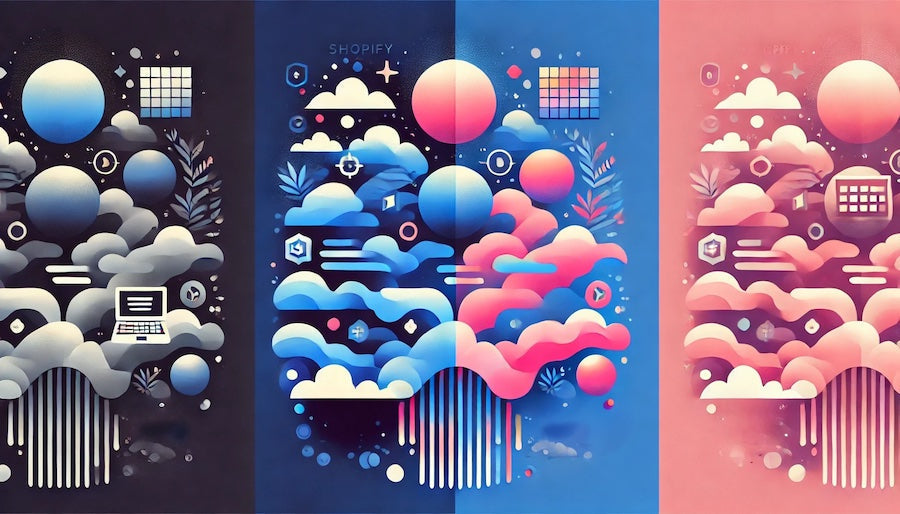One of Shopify's biggest advantages is that the App Store offers over 8,000 extensions for your online store. This allows you to customize the functionality you need from the existing offerings—without any programming knowledge.
However, Shopify also offers you the option to intervene in the code and make your own customizations. Whether custom coding or using apps makes sense depends on your use case. To help you decide, this article compares the advantages and disadvantages of Shopify apps and custom programming.

Our e-commerce expert Adrian has already helped numerous brands launch on Shopify. In his book, Shopify for Dummies, he provides retailers with all the essential information they need to navigate Shopify ( view on Amazon / view at your local bookstore ).
1. Advantages of apps
1.1. No development effort
Adding new features to an online store typically requires significant programming effort. This requires a lot of resources, including planning, design, and programming. However, using an app eliminates this effort. The functionality, with all its diverse application possibilities, is already there – you just need to install it.
1.2. Immediate availability
You can use the functionality directly and integrate it into your store. Only installation is required. This saves you valuable time, as the apps are ready to use right away.
1.3. No risks
Since apps are quick to install, no upfront investment is required, and there's usually a free trial period with no minimum term, you're always on the safe side. This allows you to thoroughly test whether the application really suits you and your needs.
1.4. Direct integration with Shopify
Apps from the App Store work seamlessly with Shopify. There are no complications; instead, the functionality is utilized optimally, and data is exchanged seamlessly between the app and Shopify. For you, this means a seamless experience without any headaches.
1.5. Interfaces to other apps
Many apps offer integration not only with Shopify, but also with many other popular and frequently used apps. These apps communicate with each other and exchange information, making their functionality even better and more seamless. Overall, this makes it easy to create a holistic customer experience and reduce the administrative burden for you as a merchant.
1.6 Continuous development and updates
To stay on the App Store, developers must continually keep their apps up to date. However, you don't have to pay anything extra for maintenance, support, and further development. This is all covered by the monthly fee.
Which apps do our experts recommend most? You can find our list of the best Shopify apps on the blog.
2. Disadvantages of Shopify Apps
2.1. Monthly costs are piling up
If you install a lot of apps, the monthly fees can quickly add up. This results in a significant amount of app-only costs. So, carefully consider whether the benefits justify the cost for each app and always keep an eye on your total expenses.
2.2. Slow loading times
Having many apps loaded in the storefront can significantly impact your online store's loading times. Every additional app loaded for visitors can slow down the store. Therefore, we recommend: less is often more.
2.3. Limited customization options
Because the apps are developed by third-party developers and don't provide full access to the internal settings, customization is limited. You can only change the options provided by the developers. This means you may not be able to customize everything the way you want.
2.4. Developed by third parties
Many Shopify apps are created by third-party developers, not Shopify itself. These apps therefore run on the developers' servers, not Shopify's. In most cases, this shouldn't be a problem, but it can be relevant in special situations. If you expect a large influx of visitors, for example, due to a TV broadcast or a major influencer campaign, smaller apps may experience difficulties. Data protection and other legal requirements should also be reviewed on a case-by-case basis.
3. When do Shopify apps make sense?
In our view, it helps to differentiate between frontend and backend apps to answer this question:
Backend apps on Shopify
Backend apps are apps that simplify store management and, as the name suggests, provide backend functionality. These include Shopify apps for invoicing, accounting, or shipping.
Backend apps automate those work processes that run in the background. Their functions are available only to retailers and their teams, offering interfaces to external providers, such as Billbee (accounting and inventory management system), Sendcloud (connection to shipping service providers and logistics management), DHL, or Klaviyo (email marketing).
In this case, using apps makes absolute sense because they automate and significantly simplify work processes.
Frontend apps on Shopify
Things get a little more complicated with front-end apps. These are the apps on Shopify whose features visitors and customers can access and use. These features are visible in the store and have a direct impact on how visitors and customers navigate the store and their user experience and customer journey, such as ratings, reviews, wish lists, or social media integration.
And precisely because front-end apps influence the user experience and the customer journey of visitors and customers, you should think more carefully about whether you should use a Shopify app or prefer custom coding, and if you decide to use Shopify apps, which ones to choose.
4. When do we recommend custom coding?
Custom coding is suitable if you need a unique design and specific features that are 100% tailored to your brand and store. However, it comes with higher costs, longer development times, and requires programming expertise.
Cross- and upselling
Although there are many apps available for this, we often recommend custom coding. Products in cross-selling and upselling are often displayed at critical points in the purchase process, such as in the shopping cart or on the product page. If an app slows down these pages or the products appear with a delay, it leads to customer frustration. In the worst case, they abandon the purchase and leave the site. Therefore, it is better to use a native, more fluid solution using custom coding in these places.
For TEVEO , for example, we implemented a cross-sell section for looks that are frequently bought together:

An alternative are themes with native cross-selling features, such as the Impact Theme. You can find an overview of our top themes for Shopify in our blog.
Gamification
For gamification, such as progress bars in the shopping cart, we also rely on custom coding. The design of many gamification apps often doesn't suit European tastes. Many of these apps originate from the US and Asia, where cartoon-like designs are popular, but they don't always resonate well in the DACH region. In our experience, a custom-designed solution usually meets aesthetic requirements better.
Our progress bar for the minimum order value in the shopping cart, developed for 3Bears , shows what individual gamification tailored to the respective brand can look like:

Shopify has evolved significantly in recent years and offers its own extensions, such as the Search & Discovery app for advanced filtering functions. Furthermore, Metafields and Metaobjects natively cover many desired features. Learn everything you need to know about them here.
5. Conclusion
Shopify apps undoubtedly offer many advantages: they're ready to use and require no coding or design skills. And, especially if your financial resources are limited, they offer important features at a relatively low price. The Shopify App Store undoubtedly offers the largest selection of extensions in all of e-commerce, and many of them are of the highest quality.
However, their use can also be counterproductive in certain cases, for example, if they affect waiting times. Furthermore, they are limited in their customization options. Retailers with particularly high demands for individual design and unique functionality will reach their limits here.
In these cases, we actually recommend custom coding, provided costs and available resources allow. The result is flexible, native functionality in a highly customized design.


